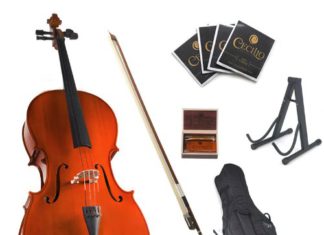It is often frustrating when you do not produce the sound that you intended to produce while playing your cello. You know you have the skills and talent. And you are pressing the right strings of your cello. What then could possibly be wrong?
The problem could be your cello. When the note you are trying to play sounds different from the other notes you play, your cello may be suffering from wolf tones. This could be a burden to some, especially those who are still new to playing the cello. However, don’t you fret because we will help you solve your dilemma! On this article, we will discuss how to get rid of cello wolf tones, a very common cello issue.
What are Cello Wolf Tones?
Before we delve further on how to get rid of cello wolf tones, it is important that you know what these are. This way, you would distinguish the sound and remove it immediately.
A cello wolf tone is a sound that your instrument produces when the vibrations of the string you played match the natural resonating vibration of your cello’s body. This creates a sustaining artificial overtone that intensifies and inflates the frequencies of the original note. An oscillating or stuttering beating usually accompanies a wolf tone because of the irregular frequencies in between the artificial overtone and the natural note. The overall sound produced could be compared to the howling of a wolf, hence the name. As a matter of fact, wolf tone could simply be called a wolf.
Wolf tones could only be noticed on bowed instruments such as the cello. This is because the tones which these instruments produce are played for a longer period. Hence, they are easier to listen to. Usually, the wolf tone could be found along the range of the pitches E and F# on your cello.
To a lot of cellists, wolf notes are a bane in their performance. While it could be remedied at some point, some players still find it confusing. Whether they may be beginners or professionals, many of the cellists still find it difficult to distinguish a wolf tone.
But here is some good news. You could actually minimize the wolf tone to the point that you could not hear it already. There are various suppressors of wolf tones. However, many cellists would recommend the use of wolf tone eliminators
What is a Wolf Tone Eliminator?
A wolf tone eliminator is a piece of equipment that can reduce or even eliminate the cello’s wolf. This is composed of a metal tube and a mounting screw that fits around the wrong string directly below the bridge of your instrument. The placement of the eliminator can affect the frequency of the wolf. Hence, you could eliminate these annoying tones if you place the tube in the right position.
Many wolf tones are small and are easy to install. Some of them are even affordable, so you could purchase them without getting much from your wallets.
These tubes come in two primary groups: interior wolf tone eliminator and exterior wolf tone eliminator. The interior wolf tone eliminator is usually custom made and are installed professionally. On the other hand, exterior wolf tone eliminators are made in bulk and just attached to the lower part of the string. Hence, they come in variants: the one with the solid brass and the other with the traditional brass cap.
How Does a Wolf Tone Eliminator Work?
Now that you know what wolf tone eliminators are, it is right to understand how they work. Since they are attached to the offending string, they lessen the vibrations that are produced from the said string, thus diminishing the vibrations which occur the wolf tone. This makes the wolf faint.
If you want to target a specific note that move in various positions, you could modify the placement of the wolf tone eliminator under the bridge of the string.
What Other Tools Would You Use to Rid of Wolf Tones?
Wolf tone eliminators are great tools for your cello. However, there are other gadgets that you could use to suppress the wolf tones and help you bring about a stellar sound. Mutes and suppressors are great alternatives for reducing the effect of the wolf tone. This is because they are less intrusive as compared to other products.
Mutes, in particular, are cheaper and more convenient to use. In using a mute, you need to look for the ideal location between the tailpiece and the bridge where you could place the tool in order to get rid of the wolf. Usually, the locations are around three-quarters of the way to the bridge.
Suppressors, on the other hand, could fit on a specific string. Like the mute, you could place your suppressors in the same area in between the tailpiece and the bridge. Typically, a suppressor includes a brass tube that surrounds a rubber tube. A string by a screw holds these tubes together. These tools are specifically designed so that you would not need any rubber or screw to affix them. You should note, however, that the resonance frequency when suppressors are used is narrow banded.
Mutes, suppressors, and even wolf tone eliminators are great tools to eliminate wolf tones. However, be mindful of some repercussions. Some cellists argue that using these tools could lessen the tone, color, and the vibrations of your cello. However, the degree of your success would be higher.
Techniques to Suppress Cello Wolf Tones
One of the techniques to suppress cello wolf tones is by using free string resonator. While technically demanding, using this resonator is an efficient way to control a wolf. The wolf is tamed when you halt at the same note as the wolf on a free adjacent string.
Another way to suppress the cello wolf tones is by identifying the central note of your wolf tone. Try experimenting with different dynamics in order to determine the worst note. Fit the suppressor or the eliminator on the C or G string and bow the shorter length of the offending string in between the suppressor and the bridge closely.
Finally, it is worth noting that a successful tuning of your cello strings would surely reduce wolf notes while ensuring that your cello’s sound is above par.
Conclusion
By this point, we hope that you have already figured out how to get rid of wolf tones. We hope that our guide has given you an idea what to do when your cello starts producing that wobbly sound that is most likely annoying.
Table of Contents












